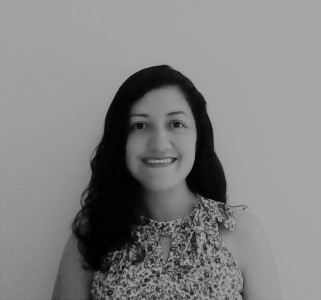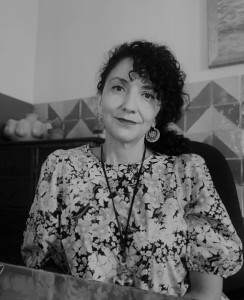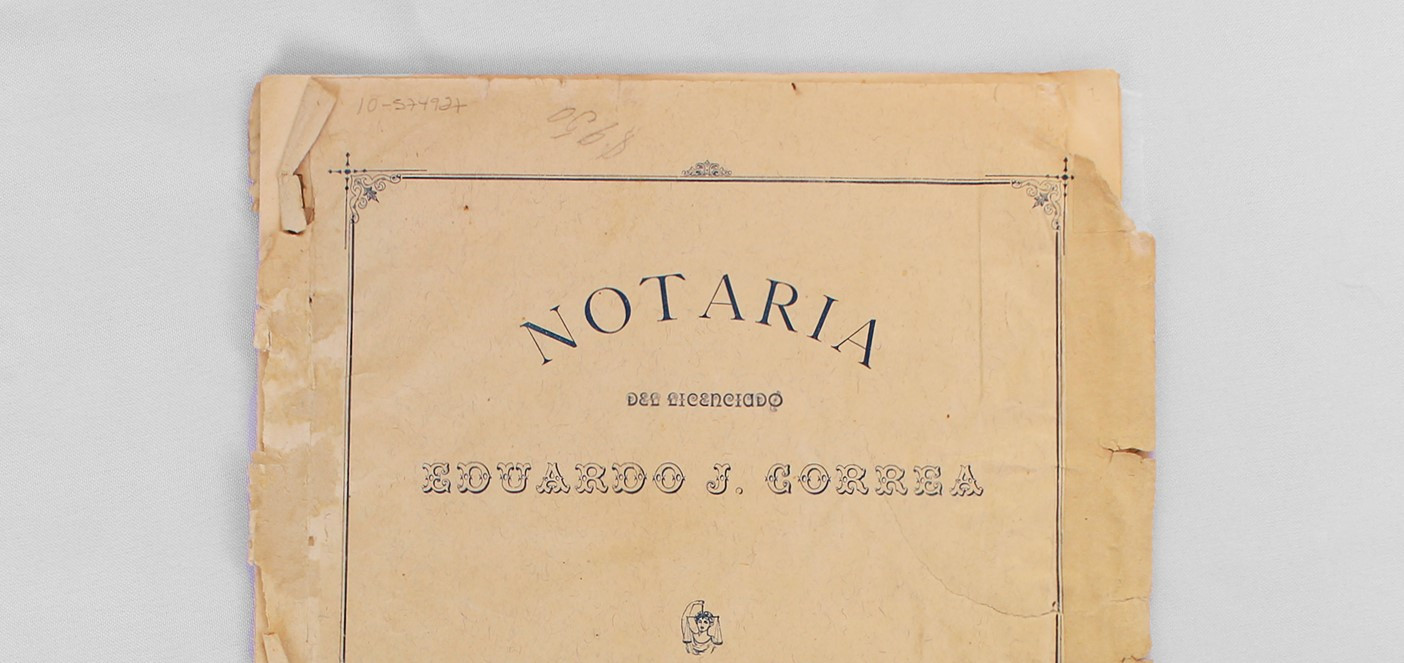Expert opinion
Centro Comunitario Culhuacán
We all have our own story and at the same time are part of one. By this we refer to the collective history that involves us with other individuals at key moments and places over the passage of time. Museum collections bear witness to this, and their contents allow us and invite us to learn a little more about the past.
The history that is inside and behind each collection motivates scholars to continue to explore the information they contain, and non-specialists likewise, by which we mean to say that the collections are not only intended for a specific group, and “may not be considered the patrimony only of a privileged few or of aficionados”;[1] each document or piece of material found in the collection makes it possible to restore part of the historical memory of our geographical region, and in some cases that of other regions, since collections may comprise one or more subjects.
The Documentary Collection of the Aguascalientes Regional History Museum (MRHA)
This historical archive contains documents mostly dating from the 19th century, mainly of a judicial character such as lawsuits, legal proceedings, legal rulings and legal claims, accounts, reports and circulars, deeds and property titles, as well as receipts of sale-purchase, letters and other bureaucratic procedures and many others on issues related to education and the military. The documents found in the MRHA collection help us to understand more about the history of our city and the surrounding area, and as mentioned above with regard to donations to the museum, not only include documents, but also various materials which “concern historical observation: the vestiges of the past (…) [the so-called] unwritten testimonies.”[2]
The collection of the MRHA comprises documents originally from Zacatecas, Rincón de Romos, San José de Gracia, Pabellón, Asientos and the city of Aguascalientes itself, together with a few referring to Mexico and Jalisco; the oldest document dates from 1709 and is a circular from Zacatecas of which 25% is preserved; while the most recent document dates from 1926 and is a receipt for interest paid from Aguascalientes.
According to the Directorate of the Public Registry of Monuments and Archaeological Zones (DRPMZA) the glossary of types of documents is used for cataloguing archives, in line with which the museum’s documents were identified as:
The documentary types that make up the collection are:
Recently, on the occasion of the centenary of the death of Zacatecas-born poet Ramón López Velarde, this museum was responsible for curating the temporary exhibition “Patria Diamantina, Allegorical Notes on Ramón López Velarde.” This exhibition involved eleven museums and one private collector, who together loaned 95 objects.
When we began to search for objects that could form a part of these major show, the curating department discovered an unpublished document that had never previously been put on show: Testimonio de la Notaría de Eduardo J. Correa, de la transacción otorgada entre Guadalupe López Velarde y el apoderado de la señora Bernarda viuda de Puga.
In the town of Jerez, Zacatecas, in the early morning of June 15, 1888 José Ramón Modesto López Velarde Berúmen was born to a Catholic family. He was the first of eight children and the only one to dedicate himself to literature. His father, the notary José Guadalupe López Velarde was a native of Paso de Sotos, today in the municipality of Villa Hidalgo, Jalisco; and his mother, María Trinidad Berúmen was from Jerez. He lived in Jerez until 1898. His native land served as a source of inspiration for his imagination.
In 1898 the López Velarde Berúmen family moved from Jerez to the city of Aguascalientes, which at that time was experiencing economic prosperity thanks to the industries established there. After Ramón completed his studies in the Seminario Conciliar de Aguascalientes, in 1906 he entered the Institute of Sciences to prepare his university entrance.
In January 1908 the poet began his university studies in Law at the Literary and Scientific Instituto of San Luis Potosí; in November of the same year, his father died in Aguascalientes and his mother and siblings returned to Jerez.
The poet’s father is worth an aside. Guadalupe López Velarde, a lawyer, came to Aguascalientes in 1897 to work as a city attorney for the council, and from that point on he also dedicated himself to the sale of real estate on the outskirts of the city, near the workshops of the Mexican Central Railroad. A year later, as mentioned above, the family finally settled in the center of the city. Don Guadalupe began a close friendship with the notary Eduardo J. Correa, who was also a journalist, poet and politician.
The notarized agreement that forms a part of the documentary collection of the MRHA is dated in 1897, and details a sale-purchase contract between the father of the poet and Ms. Bernarda viuda de Puga, who sold him some lands close to what today is known as Los Arquitos. This is a building complex built in the 19th century as one of the first public washrooms, strategically located close to the railroad station.
It is also important to note that Eduardo J. Correa founded the newspaper El Observador, where the Zacatecas-born poet published a poem entitled Suiza for the first time in 1906. This leading figure in the Catholic press of the period became one of the poet’s closest friends and always offered Ramón opportunities to publish journalistic articles on politics, reviews of films and events, as well as his literary output, in the various media he edited.
As a result, this document brings together two figures very close to Ramón López Velarde, and this agreement that makes Don Guadalupe the owner of land in this area, tells us about the life of the family in the Aguascalientes. To this day the full biography of the father of the poet Ramón López Velarde remains incomplete.
The only poem in which Ramón alluded to the death of his father is El piano de Genoveva:
Ramón López Velarde
El piano de Genoveva (fragment)
[1] Elizabeth Buchanan Martín del Campo, Aguascalientes: la Historia y sus Instrumentos, Guía de Fuentes Documentales, (Aguascalientes: ICA, 1992), 13.
[2] Ibíd., 223.
The history that is inside and behind each collection motivates scholars to continue to explore the information they contain, and non-specialists likewise, by which we mean to say that the collections are not only intended for a specific group, and “may not be considered the patrimony only of a privileged few or of aficionados”;[1] each document or piece of material found in the collection makes it possible to restore part of the historical memory of our geographical region, and in some cases that of other regions, since collections may comprise one or more subjects.
The Documentary Collection of the Aguascalientes Regional History Museum (MRHA)
This historical archive contains documents mostly dating from the 19th century, mainly of a judicial character such as lawsuits, legal proceedings, legal rulings and legal claims, accounts, reports and circulars, deeds and property titles, as well as receipts of sale-purchase, letters and other bureaucratic procedures and many others on issues related to education and the military. The documents found in the MRHA collection help us to understand more about the history of our city and the surrounding area, and as mentioned above with regard to donations to the museum, not only include documents, but also various materials which “concern historical observation: the vestiges of the past (…) [the so-called] unwritten testimonies.”[2]
The collection of the MRHA comprises documents originally from Zacatecas, Rincón de Romos, San José de Gracia, Pabellón, Asientos and the city of Aguascalientes itself, together with a few referring to Mexico and Jalisco; the oldest document dates from 1709 and is a circular from Zacatecas of which 25% is preserved; while the most recent document dates from 1926 and is a receipt for interest paid from Aguascalientes.
According to the Directorate of the Public Registry of Monuments and Archaeological Zones (DRPMZA) the glossary of types of documents is used for cataloguing archives, in line with which the museum’s documents were identified as:
| 18 accounts |
18 receipts |
| 2 lawsuits |
2 copies |
| 3 legal proceedings |
15 letters |
| 2 legal rulings |
1 IOU |
| 1 legal claims |
2 birth certificates |
| 24 reports |
2 memorandums |
| 8 circulars |
5 procedures |
| 3 licenses |
7 communications |
| 1 list |
1 payment order |
| 1 diploma |
4 property titles |
| 12 deeds |
|
The documentary types that make up the collection are:
- Correspondence: agreements, circulars, communications, copies, procedures and memorandums.
- Governance: military, church, reports.
- Education: reports.
- Legal: lawsuits, claims, civil and criminal law, sentences.
- Business: accounts, lists, payment orders, IOUs, receipts.
- Notarial protocols: deeds, property titles.
- Miscellaneous: diplomas, censuses and notifications.
Recently, on the occasion of the centenary of the death of Zacatecas-born poet Ramón López Velarde, this museum was responsible for curating the temporary exhibition “Patria Diamantina, Allegorical Notes on Ramón López Velarde.” This exhibition involved eleven museums and one private collector, who together loaned 95 objects.
When we began to search for objects that could form a part of these major show, the curating department discovered an unpublished document that had never previously been put on show: Testimonio de la Notaría de Eduardo J. Correa, de la transacción otorgada entre Guadalupe López Velarde y el apoderado de la señora Bernarda viuda de Puga.
In the town of Jerez, Zacatecas, in the early morning of June 15, 1888 José Ramón Modesto López Velarde Berúmen was born to a Catholic family. He was the first of eight children and the only one to dedicate himself to literature. His father, the notary José Guadalupe López Velarde was a native of Paso de Sotos, today in the municipality of Villa Hidalgo, Jalisco; and his mother, María Trinidad Berúmen was from Jerez. He lived in Jerez until 1898. His native land served as a source of inspiration for his imagination.
In 1898 the López Velarde Berúmen family moved from Jerez to the city of Aguascalientes, which at that time was experiencing economic prosperity thanks to the industries established there. After Ramón completed his studies in the Seminario Conciliar de Aguascalientes, in 1906 he entered the Institute of Sciences to prepare his university entrance.
In January 1908 the poet began his university studies in Law at the Literary and Scientific Instituto of San Luis Potosí; in November of the same year, his father died in Aguascalientes and his mother and siblings returned to Jerez.
The poet’s father is worth an aside. Guadalupe López Velarde, a lawyer, came to Aguascalientes in 1897 to work as a city attorney for the council, and from that point on he also dedicated himself to the sale of real estate on the outskirts of the city, near the workshops of the Mexican Central Railroad. A year later, as mentioned above, the family finally settled in the center of the city. Don Guadalupe began a close friendship with the notary Eduardo J. Correa, who was also a journalist, poet and politician.
The notarized agreement that forms a part of the documentary collection of the MRHA is dated in 1897, and details a sale-purchase contract between the father of the poet and Ms. Bernarda viuda de Puga, who sold him some lands close to what today is known as Los Arquitos. This is a building complex built in the 19th century as one of the first public washrooms, strategically located close to the railroad station.
It is also important to note that Eduardo J. Correa founded the newspaper El Observador, where the Zacatecas-born poet published a poem entitled Suiza for the first time in 1906. This leading figure in the Catholic press of the period became one of the poet’s closest friends and always offered Ramón opportunities to publish journalistic articles on politics, reviews of films and events, as well as his literary output, in the various media he edited.
As a result, this document brings together two figures very close to Ramón López Velarde, and this agreement that makes Don Guadalupe the owner of land in this area, tells us about the life of the family in the Aguascalientes. To this day the full biography of the father of the poet Ramón López Velarde remains incomplete.
The only poem in which Ramón alluded to the death of his father is El piano de Genoveva:
Me pareces, oh piano, por tu voz lastimera,
una caja de lágrimas, y tu oscura madera
me evoca la visita del primer ataúd
que recibí en mi casa en plena juventud.
Piano de Genoveva, te amo por indiscreto;
de tu alma a todo el mundo revelas el secreto;
cuenta, uno por uno, todos tus desengaños.
Piano llorón, la hermosa más hermosa del valle
se nos ha vuelto triste porque tiene treinta años
y no hay por todo el pueblo quien ronde por su calle.
Genoveva, regálame tu amor crepuscular:
esos dulce treinta años yo los puedo adorar.
¡Ruégala tú que al menos, pobre piano llorón,
con sus plantas minúsculas me pise el corazón!
[You seem to me, oh piano! By your plaintive voice,
a box of tears, and your dark wood
It reminds me of the visit of the first coffin
that I received in my house in full youth.
Genoveva’s piano, I love you for being indiscreet;
from your soul to the whole world you reveal the secret;
you count, one by one, all your disappointments.
Weeping piano, the most beautiful beauty in the valley
he has made us sad because he is thirty years old
and there is not all over the town that roams his street.
Genoveva, give me your twilight love:
Those sweet thirty years I can adore them.
Beg her that at least, poor crying piano,
step on my heart with its tiny plants!]
Ramón López Velarde
El piano de Genoveva (fragment)
[1] Elizabeth Buchanan Martín del Campo, Aguascalientes: la Historia y sus Instrumentos, Guía de Fuentes Documentales, (Aguascalientes: ICA, 1992), 13.
[2] Ibíd., 223.
Under translation
Under translation
LEGAL NOTICE
The contents of this website belong to the Instituto Nacional de Antropología e Historia de México, and may be downloaded and shared without alterations, provided that the author is acknowledged and if is not for commercial purposes.








